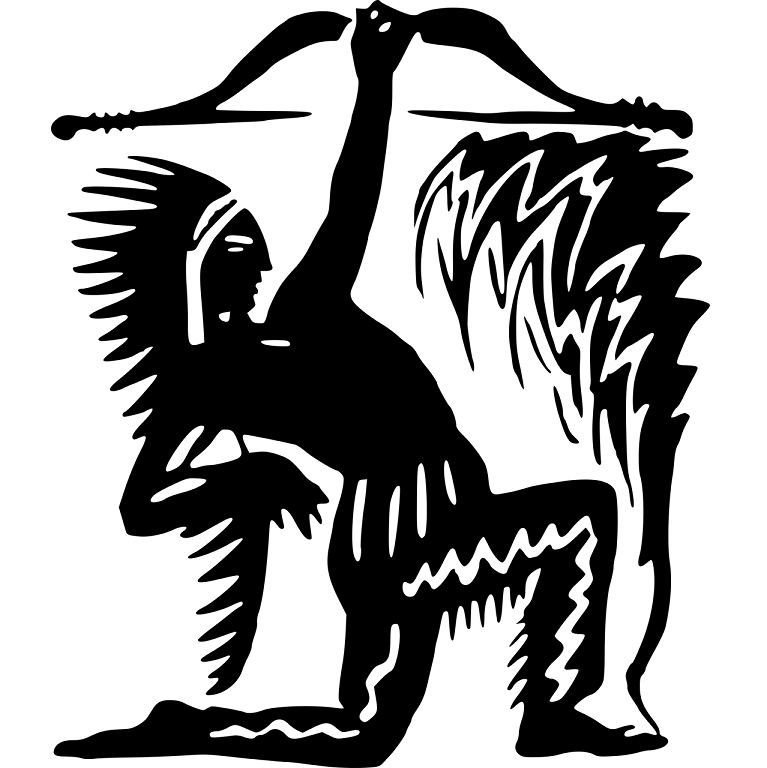The Scouts would arrive on Sunday morning and depart the following Saturday morning, all working on merit badges through the courses provided. There were, give or take, a hundred and twenty-five per week. We had a six-week camping schedule*. On Tuesday evenings, the families of the Scouts were invited to come up for a visit, which included food, speeches, presentations, and performing Indians at the lake. I was one of the Indians.
We Scouts on the staff anticipated the arrival of the families, as we were now of the age where we were fully into the boy/girl thing. Perhaps a pretty sister would be would make a visit.
After eating, and nearing sunset, we gathered at the beach where there was a staging area and seating. We began the evening’s program demonstrating, if need be, how we would drag the lake with an implement fitted with large hooks, pulling it along the lake bottom with a rowboat, back and forth, hoping to snag a hapless drowning victim. Thankfully, we had had no occasion to use the device.
Speeches by Scout leaders, awards, and upcoming events, began the program in earnest. When this part of the program started, fifteen of us “Indians” slipped off to the bathhouse where we dressed up.
We put on red body paint, and donned our moccasins, leggings, loincloths, feathers, bells, face-paint, and our mohawk headdresses, most of which was self-made. We were drummers, dancers and warriors. We thought we looked pretty good, and of course, we considered ourselves the main event.
Then, the Chief and I headed around back and across the bridge to the east side of the lake. A Scout was positioned on the west side across from us where a canoe had been hidden, waiting in the shadows and at the ready.
Now, as twilight settled in, the camp lights came on, and the remaining Indians then ran through the audience to the stage area and began a circle dance around the group of drummers that seated themselves in the middle.
There was a lot of whooping and twirling and jumping up and down making a lot of noise to set up the following events. As the dance ended, they repositioned themselves on the stage perimeter, and the drummers started drumming a slow beat.
I pulled on the slack of over 200’ of rope attached to the canoe across the lake signaling the Scout to light a torch, which he placed in the bow of the canoe. I then began pulling the torchlit, but empty canoe, through the darkness across the lake. It was a really cool effect.
As I slowly reeled in the canoe, Bill, the Chief, finished his dress-up. He was in buckskin and beads, and wore a full-feathered headdress. He was all dressed up, and regal, looking the part.
When the canoe reached us, hidden waterside by trees and brush, I doused the torch, untied the tow rope from the canoe, and turned the canoe around. Chief Bill would step in and move up to the bow, standing with arms crossed, holding a ceremonial peace pipe. I slowly pushed us off, jumped in, and began paddling us toward the audience a few hundred feet distant at the beach.
We came into view as we closed the distance and entered the camp lights’ glow. The drummers kept up the slow beat.
I had one job. And that was to get the Chief onto the landing platform without him falling in the water. After all, I was the canoeing instructor! I know a few side bets were placed as to whether I would pull it off. Stepping onto the platform from the canoe with no hands was tricky. I only spilled him once. HA! LOL! Just kidding. We never had a mishap.
He stretched out his arm in hailing fashion, then stepped gracefully onto the landing. The drums stopped. Chief Bill strode to center stage to deliver his speech.
As he began, I paddled the canoe around the side into the backwater, landed the canoe, and hoofed it to the bathhouse to complete the costuming for my part as one of two dancers in the Eagle dance. I added more feathers to my arms and back.
Our time came, the last “act” of the Indian’s participation in the evening’s festivities.
With drums beating we swooped in from opposite sides of the stage soaring high and circling each other as we spiraled down. We repeated the ups and downs. We were happy and flying free. The drums beat faster and as we were about to pull out of a dive for another climb, a shot rang out from a hunter below, and one of the eagles plummeted to the ground, with the other eagle quickly climbing and disappearing into the distance off stage.
The lights turned off and the drums stopped. And it was dark, and still.
The Indians made their exit in the darkness. The lights came on, and there was applause, which of course, we relished.
The closing of the evening’s program proceeded as we doffed our costuming and showered off the body paint. And redressed as Scouts, we headed out to mingle with the crowd, perhaps catching the eyes of a pretty sister.
The time I spent in Scouting was some of the best times I ever had.
*Camp Edgewood hosted the troops of the Calcasieu Area Council Boy Scouts of America. My troop was the Quelqueshoe Lodge 166. The Quelqueshoe Indians, or Calcasieu, as the early French and Spanish settlers called them, inhabited the area of southwestern Louisiana. It was the name of one of the tribal chiefs. They also had ceremonial cannibalistic tendencies. The root of the name derived from Central America. It means Screaming Eagle.





Thanks James!!!! It's great of you to do this.
Very impressed with the “Eagle” program and your participation.